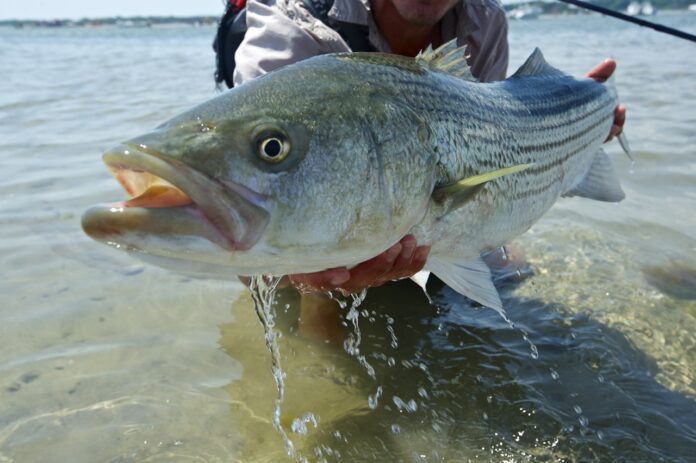Welcome to the latest installment of the Wednesday Wake-Up Call, a roundup of the most pressing conservation issues important to anglers. Working with our friends at Trout Unlimited, Backcountry Hunters & Anglers, the Theodore Roosevelt Conservation Partnership, The Everglades Foundation, Captains for Clean Water, VoteWater.org, and Conservation Hawks (among others), we’ll make sure you’ve got the information you need to understand the issues and form solid opinions.
1. A Huge Win for Atlantic Striped-Bass Populations
Photo by Sandy Hays
Yesterday, the Atlantic States Marine Fisheries Management Commission’s Striped Bass Board approved two historic actions to conserve the prolific 2015-year class and to improve the probability of rebuilding the striped bass stock by 2029. First, the Board initiated Addendum II, which will address recreational overages and put the stock back on track for rebuilding by 2029. Second, the board enacted an Emergency Action, which will implement a 28-to-31-inch slot limit for the entire coast–effective as soon as possible and no later than July 2. Had the Board not acted today, the odds of rebuilding the population would have just 11-15% due to the dramatic increase in recreational harvest in 2022. While the road to striped bass recovery is still a long one, the Board’s strong conservation-minded action today can give the entire striped bass community hope that this stock will rebuild and that the Board can make the hard but necessary decisions to manage striped bass.
ASGA is incredibly thankful for the thousands of anglers, brands, and fishing guides who spoke up for the health of the stock and called on the Striped Bass Board to take action. The Striped Bass Board was not required to make any changes today—the Board’s action today represents an incredible moment for conserving and effectively managing the striped bass fishery.
“The conservation community spoke, and our voice was heard,” said Tony Friedrich, VP and Policy Director of the American Saltwater Guides Association, which had lobbied hard for the changes. “Fisheries management is a long arduous process. Science informed us that there was little to no chance of rebuilding the stock under the current system. We unified the community with one voice that demanded a better future for the resource and our children. Thanks to every angler, brand, and guide who spoke up and to the conservation-minded Striped Bass Board members who voted for the health of the resource.”
Rest assured, the striped bass stock is in a far better place today than a month ago, but it is far from rebuilt and out of the weeds. Watch the video at the top of this page for an explanation of the challenges facing Atlantic striped bass, and listen to the podcast below for a brief discussion of yesterday’s victory.
Click here to follow the issues on the ASGA blog
2. U.S. Army Corps to Reconsider Permit Rejection for Proposed Pebble Mine

Photo courtesy of U.S. Army Corps of Engineers
Back in January, we celebrated what seemed to be the ultimate demise of the Pebble Mine Project, when ¸the Environmental Protection Agency (EPA) issued a final determination under the Clean Water Act 404(c) that prohibits mine waste from being disposed of in the rivers and wetlands in and near the Pebble deposit. But we knew that this story would still have many twists and turns. Yesterday, just the thing we have to be on the lookout for happened:
The U.S. Army Corps of Engineers will reconsider its decision denying a permit for the proposed Pebble Mine. In 2020, the Army Corps rejected Pebble’s application for a large open-pit gold and copper mine upstream from Bristol Bay. But now the company has partially won its administrative appeal of that decision. The announcement suggests that one barrier to the controversial mine is not as solid as opponents had hoped.
Luckily, there are still many other obstacles standing between the mine’s backers, but we can expect them to keep chiseling away at those impediments in the near future.
Click here for the full story from Alaska Public Media
3. Getting City Kids Excited About Trout

Trout Unlimited is just one of many organizations who implement the Trout in the Classroom (TIC) program into more than 5000 classrooms nationwide. From kindergarten through high school, programs focus on caring for trout or salmon and their environments and expand to understanding their life cycles and then advance to water chemistry, hydrology, natural resource management and watershed geology and ecology. But the exact curriculum is mostly left up to the educators.
The New York City TIC program is the largest in the country thanks to a long-standing partnership with New York’s Department of Environmental Protection. In an effort to educate New York City school children about their drinking water, its source and cleanliness, this team brings Trout in the Classroom to youth who have little to no access to nature.
Click here for the full story on TU.org
Credit: Source link































